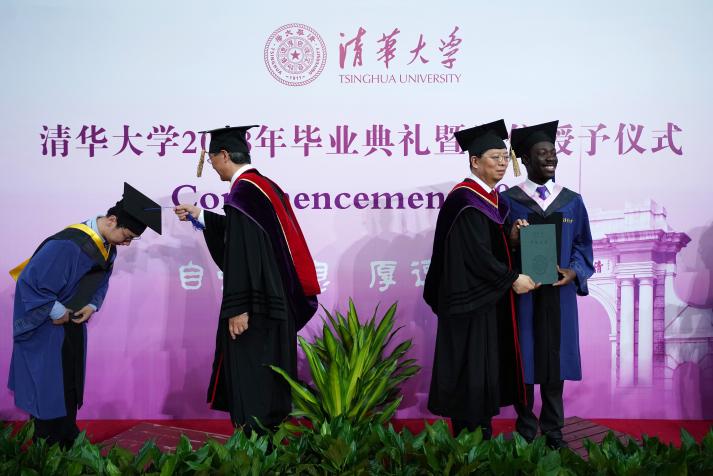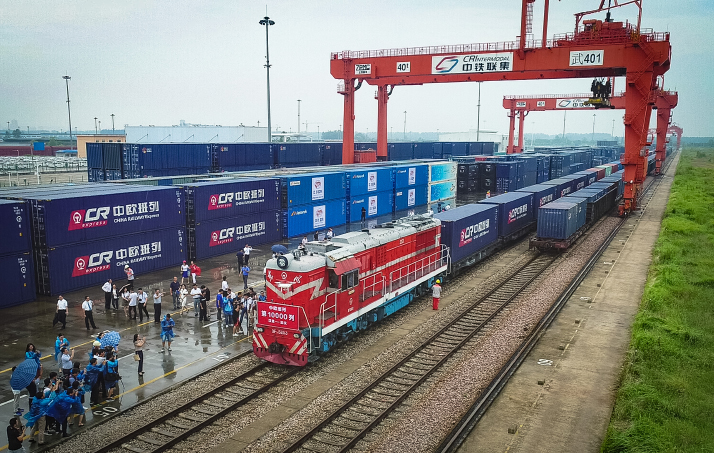|
||||||||||
| Home Nation World Business Opinion Lifestyle ChinAfrica Multimedia Columnists Documents Special Reports |
|
||||||||||
| Home Nation World Business Opinion Lifestyle ChinAfrica Multimedia Columnists Documents Special Reports |
| Current Cover Story |
| Giant Leap for Mankind |
| Over the last five years, the Belt and Road Initiative has made significant progress in inclusive development |
| By Li Xiaoyu | VOL.10 October 2018 ·2018-09-27 |

Every day, freight trains depart fully loaded with containers from Yiwu City in east China's Zhejiang Province, which is known as "world's largest supermarket." Trains travel more than 13,000 km before arriving in Madrid, Spain, where European consumers have easy access to goods produced in Yiwu. Meanwhile, the trains returning to China bring products such as French wine, German beer, Dutch biscuits and Polish fruit juice, all of which are gaining popularity among Chinese consumers.
Back in March 2011, the first China-Europe freight train departed from Tuanjie Village Station in southwest China's Chongqing Municipality for Duisburg, Germany. The journey is three times faster than shipping routes, and costs one-fifth that of airfreight.
Since these international trains - and many others - have been put into operation, freight has seen an increase. As of the end of August, China-Europe freight trains have traveled more than 10,000 times, serving 43 cities in 15 European countries, with an average cargo load of 85 percent.
These new rail lines are an important part of the Belt and Road Initiative, put forward by Chinese President Xi Jinping in 2013. While some countries are upholding protectionism, China, for its part, seeks to revive the legacy of historic trade routes by transforming them into a modern example of inclusive growth and transcontinental cooperation.
Five years on, more than 100 countries and international organizations have signed cooperation agreements with China under this initiative. Statistics from the National Development and Reform Commission show that as of September 7, China had signed memoranda of understanding with 37 African countries and the African Union on jointly developing the Belt and Road. Many countries and regions along the Belt and Road routes have considered aligning the initiative with their own development plans. Several major international organizations, such as the United Nations, have even adopted the initiative's core concepts such as concertation, synergy and sharing.
In addition to policy coordination, the last five years have also seen the development of the Belt and Road Initiative in other aspects, be it infrastructure connectivity, unimpeded trade, financial integration, and strengthened people-to-people ties.
Infrastructure connectivity
Infrastructure connectivity is one of the major objectives of the Belt and Road Initiative. According to Alexey Maslov, Director of the School of Asian Studies at the National Research University of Russia, infrastructure connectivity has been the most successful area of cooperation under the initiative.
He said that there has been a significant expansion of investment in infrastructure projects in Europe, Asia and other regions. This also includes infrastructure development in areas where such projects were virtually non-existent before, such as the China-Pakistan Economic Corridor.
Raphael Tuju, Secretary General of Kenya's ruling Jubilee Party, agrees. He believes that the Belt and Road Initiative has brought about a real boom in the development of modern infrastructure in African countries, such as the Mombasa-Nairobi Standard Gauge Railway (SGR) in Kenya, the Addis Ababa-Djibouti Railway, and the Maputo Bridge in Mozambique.
Tuju noted that the Belt and Road Initiative has been vital as it has opened up the hinterland. According to him, the 480-km-long Mombasa-Nairobi SGR puts Kenya in a good position to advance its industrial agenda and become a regional trading platform.
Unimpeded trade
When it comes to trade, one of the priorities of the Belt and Road Initiative, results are equally convincing. According to statistics released by the Ministry of Commerce of China, as of June 2018, China's trade in goods with countries participating in Belt and Road construction exceeded $5 trillion, and China has become the largest trading partner of 25 participating countries.
It should be noted that trade goes in both directions. According to a think tank of China's State Council, China's imports from Belt and Road countries grew faster than its exports to these same countries for the first time in 2017. In fact, while China's imports from these countries amounted to $666 billion, a year-on-year increase of 20 percent, imports reached $774 billion, a year-on-year increase of 8.5 percent.
In addition, over the past five years, China's direct investment in countries along the Belt and Road routes exceeded $70 billion, with an average annual growth rate of 7.2 percent. At the same time, Chinese enterprises have established 82 overseas economic and trade cooperation zones in countries along the Belt and Road routes with investment combining to $28.9 billion. The investments have created 244,000 local jobs and generated $2.01 billion in tax revenue for these countries.

Financial integration
As part of the initiative, finance has also been identified as a key area to support the construction of business networks and infrastructure connectivity between participating countries. According to the African Development Bank's 2018 African Economic Outlook, the continent needs $130 to $170 billion a year to finance its infrastructure development, and has a current shortfall of about $68 to $108 billion.
To address this issue and better finance development projects as part of the Belt and Road Initiative, China has founded the Silk Road Fund with a registered capital of $40 billion in December 2014.
Three years later, an additional 100 billion yuan ($14.6 billion) was allocated by the Chinese Government to the fund. By the end of 2017, the fund had already launched its first investment cycle by allocating approximately $7 billion to 17 projects.
Strengthened people-to-people ties
China has actively launched cooperation projects in the fields of education, science and technology as part of the Belt and Road construction. Through the implementation of the Silk Road Scholarship Program, China has established educational institutions abroad to train management professionals for countries taking part in the Belt and Road construction.
In addition, there were more than 300,000 students from participating countries studying in China in 2017; at the same time, more than 60,000 Chinese students were studying in countries along the Belt and Road routes.
Tourism is also an area boosted by the Belt and Road Initiative. It is estimated that, by 2020, the number of tourists coming and going in both directions between China and countries along the Belt and Road will exceed 85 million; and the tourism-related consumption could be as high as $110 billion, according to the Information Office of China's State Council.
Looking forward
At a symposium held in Beijing in late August marking the fifth anniversary of the Belt and Road Initiative, President Xi highlighted the way forward.
According to Xi, the next step to move the initiative forward is to achieve high-quality development. He urged partners to make efforts to accomplish full and solid cooperation within the framework of the initiative in order to benefit peoples in the countries concerned and to build a community with a shared future for mankind. He also encouraged the use of non-governmental funds to invest in infrastructure projects and to continue to develop markets abroad, while maintaining an adequate balance of trade.
Moreover, while addressing the opening of the Beijing Summit of the Forum on China-Africa Cooperation (FOCAC) on September 3, Xi called for the alignment of the Belt and Road Initiative with the AU Agenda 2063 and the United Nations 2030 Agenda for Sustainable Development, as well as the development strategies of various African countries.
This call has not been unheard. In a speech at the same event, AU Commission Chairperson Moussa Faki Mahamat said: "We need to maximize synergies between [the AU] Agenda 2063 and the Belt and Road Initiative."
"By combining the China-led initiative with infrastructure construction across Africa, such as railways, roads and other development programs, the continent will be better integrated with the global economy," said Denis Sassou-N'guesso, President of the Republic of the Congo.
(Comments to lixiaoyu@chinafrica.cn)
|
||||||||||||
| About Us | Contact Us | Advertise with Us | Subscribe |
| Copyright Beijing Review All rights reserved 京ICP备08005356号-5 京公网安备110102005860号 |